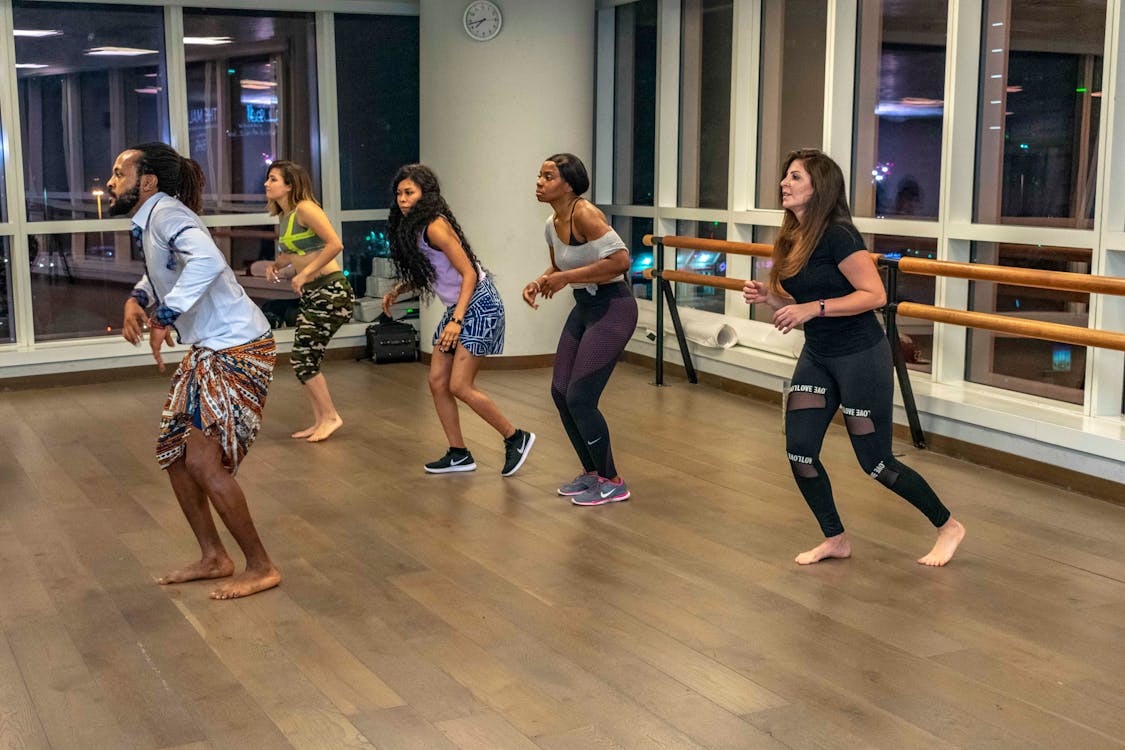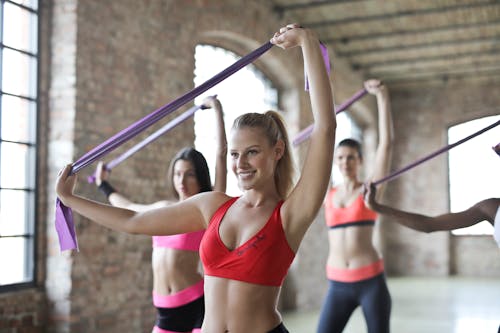As individuals, staying fit is one of the Most effective strategies for living a healthy and illness-free life.
Are you ready for a transformative journey in the fitness world? Whether you’re a newbie in the fitness world, or you’re still finding a way to balance your fitness routine, you don’t have to go too far. This blog post has all you need to start a beginner’s fitness routine.
You no longer have to wait for the perfect time or look for the best gym before you can start. All you need is determination and strength to pull through.
In this article, we’ll guide you through reasons why you need a fitness routine, types of beginner’s fitness routines, and how to start exercising.
Let’s delve in!
Article Contents
Why Beginner’s Fitness Routine Comes Highly Recommended
- For healthy weight loss
- Cardiovascular health benefits
- Chronic disease prevention
- Blood pressure regularization
- Prevent heart disease, kidney diseases
- more energy
Some Basic Types of ‘Beginner’s Fitness Routine’ Exercises or Fitness Activities
Here are some beginner fitness routines you can try:
Rock climbing

Activities in a dance class

Leg kicks

Walking lunges

Arm swings

Running

Weight training

How to Start Exercising: A Beginner’s Guide to Working Out
Exercising is a life-changing decision that positively impacts your physical, mental, and overall health. However, it can be challenging and overwhelming, especially for beginners.
To ensure a successful and sustainable journey, it’s essential to approach exercise with a well-thought-out plan and a mindset of gradual progress. Below are steps and tips to guide you through your beginner’s fitness routine.
1. Set Clear and Realistic Goals
Before diving into any exercise routine, take a moment to define your objectives. Are you aiming to lose weight, build muscle, improve endurance, or simply lead a more active lifestyle? Setting clear and realistic goals will help you stay focused and motivated throughout your fitness journey. Make sure your goals are specific, measurable, achievable, relevant, and time-bound (SMART).
2. Consult with a Healthcare Professional
If you have any pre-existing health conditions or concerns, it’s crucial to consult with a healthcare professional or personal trainer, before starting any exercise program. They can provide valuable insights into your current health status and guide you on exercise plans that suit your specific needs, fitness goals, and limitations for moderate-intensity exercise and other physical activity guidelines for starting a fitness routine or exercise program
3. Start Slow and Gradual
Avoid the temptation to jump into an intense workout routine right away. Starting slow and gradually increasing the intensity and duration of your workouts will minimize the risk of injuries and prevent burnout. Remember, consistency is more important than pushing yourself too hard too soon.
4. Choose Activities You Enjoy
The key to sticking with an exercise routine is finding activities you genuinely enjoy. Whether it’s dancing, hiking, cycling, swimming, or any other form of physical activity, incorporating things you love will make exercise more fun and engaging.

5. Create a Weekly Schedule
Establish a workout schedule that fits into your daily routine. Aim for at least 150 minutes of moderate-intensity aerobic exercise or 75 minutes of vigorous-intensity aerobic exercise per week, along with muscle-strengthening activities on two or more days per week.
6. Warm Up and Cool Down
Always start your workouts with a proper warm-up to prepare your muscles and joints for exercise. Spend 5-10 minutes doing light cardio (like brisk walking) and dynamic stretches. After your workout, cool down with static stretches to improve flexibility and reduce muscle soreness.
7. Stay Hydrated
Drink plenty of water before, during, and after your workouts to stay hydrated. Dehydration can negatively impact your performance and recovery.
8. Listen to Your Body
Pay attention to your body’s signals and avoid pushing yourself too hard. It’s normal to feel pain or some muscle soreness, but sharp pain or discomfort may be a sign of injury.
9. Mix Cardio and Strength Training
A well-rounded fitness routine should include both cardiovascular exercises (like running, cycling e.g. using a stationary bike, or dancing) and strength training (using weights or bodyweight exercises). Cardio improves heart health and burns calories, while strength training helps build lean muscle mass and boosts metabolism.
10. Track Your Progress
Keep a record of your workouts and progress to see how far you’ve come. Tracking your achievements, whether it’s increased endurance, lifted weights, or inches lost, can be incredibly motivating and help you stay on track.
11. Rest and Recovery
Allow your body ample time to rest and recover between workouts. Muscle growth and overall progress occur during rest periods, so don’t underestimate the importance of recovery days.
12. Stay Accountable
Enlist the support of a workout buddy, join fitness classes, or find online fitness communities to stay accountable and motivated throughout your journey. Sharing your progress and challenges with others can be encouraging and inspiring.
13. Be Patient and Persistent
Results won’t happen overnight. Building a fitter and healthier body takes time and dedication. Be patient with yourself and stay persistent even when faced with obstacles or setbacks.
14. Celebrate Your Achievements
Celebrate your small and big victories along the way. Recognizing your progress, no matter how small will keep you motivated and excited to continue your fitness journey.
Remember, starting an exercise routine is not just about physical transformation; it’s about fostering a positive relationship with your body, improving mental well-being, and embracing a healthier lifestyle. Embrace the process, stay committed to your goals, and enjoy the incredible benefits that regular exercise can bring to your life. Let this be the beginning of a lifelong commitment to your health and happiness.

How to Assess Your Fitness Level
Accessing your fitness level is an essential step in designing an effective workout routine that aligns with your current abilities and helps you set realistic fitness goals. Here are some methods to assess your fitness level and improve your exercise understanding
1. Cardiovascular Endurance Test:
Perform a cardiovascular endurance test to evaluate your heart and lung fitness. You can do this by performing exercises like running, cycling, or swimming and noting how long you can sustain the activity before feeling fatigued. Record the time or distance covered to gauge your endurance level.
2. Strength Assessment:
Evaluate your strength by performing basic exercises such as push-ups, squats, lunges, and planks. Take note of the number of repetitions or duration you can hold each position. This will give you an idea of your upper body, lower body, and core strength.
3. Flexibility Test:
Assess your flexibility by doing simple stretches. Reach for your toes while sitting with your legs extended, and perform shoulder stretches, and other stretches targeting major muscle groups. Note how far you can comfortably stretch and whether there’s any tightness or restriction in your movements.
4. Body Composition Analysis:
Understand your body composition by measuring your weight, body mass index (BMI), and body fat percentage. You can use body fat calipers, bioelectrical impedance scales, or professional assessments to get more accurate readings.
5. Balance and Coordination Evaluation:
Test your balance and coordination through exercises like standing on one leg with your eyes closed or performing single-leg movements. Assess how stable you are and whether you can maintain balance without wobbling or stumbling.
6. Flexibility and Mobility Screening:
Perform mobility exercises like hip circles, shoulder circles, and spinal twists to evaluate your joint mobility and range of motion. Identifying areas of limited mobility can help you work on improving flexibility and reducing the risk of injuries.
7. Rate of Perceived Exertion (RPE):
Use the Rate of Perceived Exertion scale, which ranges from 1 to 10, to gauge how hard you feel you are working during exercise. This self-assessment can give you insight into the intensity of your workouts.
8. Professional Fitness Assessment:
Consider scheduling a fitness assessment with a certified personal trainer or fitness professional. They can conduct a comprehensive evaluation, including measurements, fitness tests, and a detailed analysis of your strengths and weaknesses. This personalized assessment can help you develop a targeted workout plan.
Once you have assessed your fitness level, use this information as a baseline to set achievable goals and tailor your exercise routine to meet your specific needs and abilities. As you progress, periodically reassess your fitness level to track improvements and make necessary adjustments to your workouts. Remember, fitness is a journey, and regular assessments can help you stay on track and motivated

Easy Ways to “Sneak” More Movement into Your Daily Life
Incorporating exercise into your everyday life doesn’t have to be complicated or time-consuming. By making small adjustments to your routine, you can stay active and improve your overall fitness. Here are some easy ways to include exercise in your daily activities:
Walk or Bike Whenever Possible: Opt for walking or biking instead of driving short distances. If your workplace or grocery store is nearby, consider walking or cycling there. It’s not only a great way to get exercise but also benefits the environment.
Take the Stairs: Skip the elevator or escalator and take the stairs whenever you can. Climbing stairs is an excellent way to get your heart rate up and engage your leg muscles.
Stand and Move Regularly at Work: If you have a sedentary job, make it a habit to stand up and move around for a few minutes every hour. You can take short walking breaks or do some stretching at your desk.
Do Bodyweight Exercises During Breaks: During breaks or free moments, do some simple bodyweight exercises like squats, lunges, push-ups, or planks. These can be done almost anywhere and help maintain muscle tone.
Engage in Active Hobbies: Choose hobbies that involve physical activity, such as dancing, gardening, playing a sport, or hiking. This way, you can enjoy yourself while staying active.
Park Farther Away: Park your car farther away from your destination, whether it’s at work, the grocery store, or a shopping mall. The extra walking will add up over time.
Take Walking Meetings: If possible, have walking meetings with colleagues instead of sitting in a conference room. Walking and talking can stimulate creativity and keep you active.
Use a Standing Desk: Consider using a standing desk at work, which can help improve posture and increase calorie expenditure compared to sitting all day.
Exercise While Watching TV: Take advantage of commercial breaks to do some simple exercises like jumping jacks, squats, or leg lifts while watching TV.
Involve Family and Friends: Engage in physical activities with family and friends, such as walking together, playing sports, or taking a fitness class. Exercising with others can make it more enjoyable and help you stay motivated.
Take Active Breaks During Chores: While doing household chores, find opportunities to make them more active. For example, add in some lunges while vacuuming or dance while doing the dishes.
Play with Kids or Pets: If you have kids or pets, use playtime as an opportunity to be active. Play tag, chase a ball, or take your dog for a brisk walk.
Schedule Short Workouts: Even if you have a busy schedule, aim for short, focused workouts. Just 10-15 minutes of exercise in the morning or during lunch can make all the difference.
Wrapping Up
Accept the changing path of a fitness routine, which will favorably impact all aspects of your life. Set realistic goals, stay consistent, and choose hobbies that fascinate you. Aside from bodily benefits, exercise promotes discipline, resilience, and mental well-being. Be patient, celebrate improvements, and emphasize self-care. Take the first step today toward realizing your amazing potential and living a lively and rewarding life.

Frequently Asked Questions (FAQ)
1. What Is a Fitness Routine for a Beginner?
A beginner’s fitness routine is a planned series of exercises and activities for people who are new to fitness or exercise. It tries to progressively introduce physical exercise while taking the individual’s fitness level and goals into account.
2. What is the significance of a Beginner’s Fitness Routine?
A beginner’s fitness program is vital since it allows beginners to begin their fitness journey safely and effectively. It prevents injuries, lays a stable basis for future growth, and establishes a habit of regular physical activity.
3. How Should I Begin a Fitness Routine for Beginners?
Consider your fitness goals and current fitness level before beginning a beginner’s fitness plan. Begin with low-impact workouts such as walking, swimming, or cycling, then work your way up to strength and flexibility exercises.
4. How often should a novice exercise?
Aim for at least 150 minutes of moderate-intensity aerobic activity per week or 75 minutes of vigorous-intensity aerobic activity per week as a beginner. Include strength training activities targeting key muscle groups at least twice a week.
5. What are some helpful hints for beginners?
- Begin slowly and progressively increase your workout intensity and duration.
- To avoid injuries, warm up before exercising and cool down afterward.
- Listen to your body and rest if you are tired or in pain.
- Maintaining a balanced diet and staying hydrated will help you achieve your fitness goals.
If you’re unclear about proper form or workouts, see a fitness professional or personal trainer.
6. Is it possible to undertake a Beginner’s Fitness Routine at home?
Absolutely! Many workouts for beginners can be done at home with little to no equipment. Bodyweight exercises, yoga, and easy aerobic programs are all terrific home workout options.
7. How long will it take for a Beginner’s Fitness Routine to produce results?
The time it takes to see effects varies from person to person. With constant work, noticeable increases in strength, endurance, and flexibility can be noticed within a few weeks to a couple of months.
8. Is it possible to mix a Beginner’s Fitness Routine with other activities such as sports or dancing classes?
Yes, as long as you listen to your body and avoid overtraining, you may combine a beginner’s fitness plan with other physical pursuits. To avoid fatigue and injury, it is critical to balance diverse activities.
9. Are there any workouts that a beginner should avoid?
Heavy lifting and powerful plyometric movements are examples of high-impact or advanced activities that may not be appropriate for beginners. As your fitness level improves, it’s important to progressively graduate to more difficult workouts.
10. How can I keep myself motivated to stick to a Beginner’s Fitness Routine?
Set attainable and reasonable objectives, keep track of your progress, find a workout buddy or join a fitness community, and celebrate your victories along the way. Remember that consistency is essential, and that the journey to a better lifestyle is worthwhile.
Before beginning any new workout program, always consult with a healthcare or fitness professional, especially if you have any pre-existing medical ailments or concerns.

